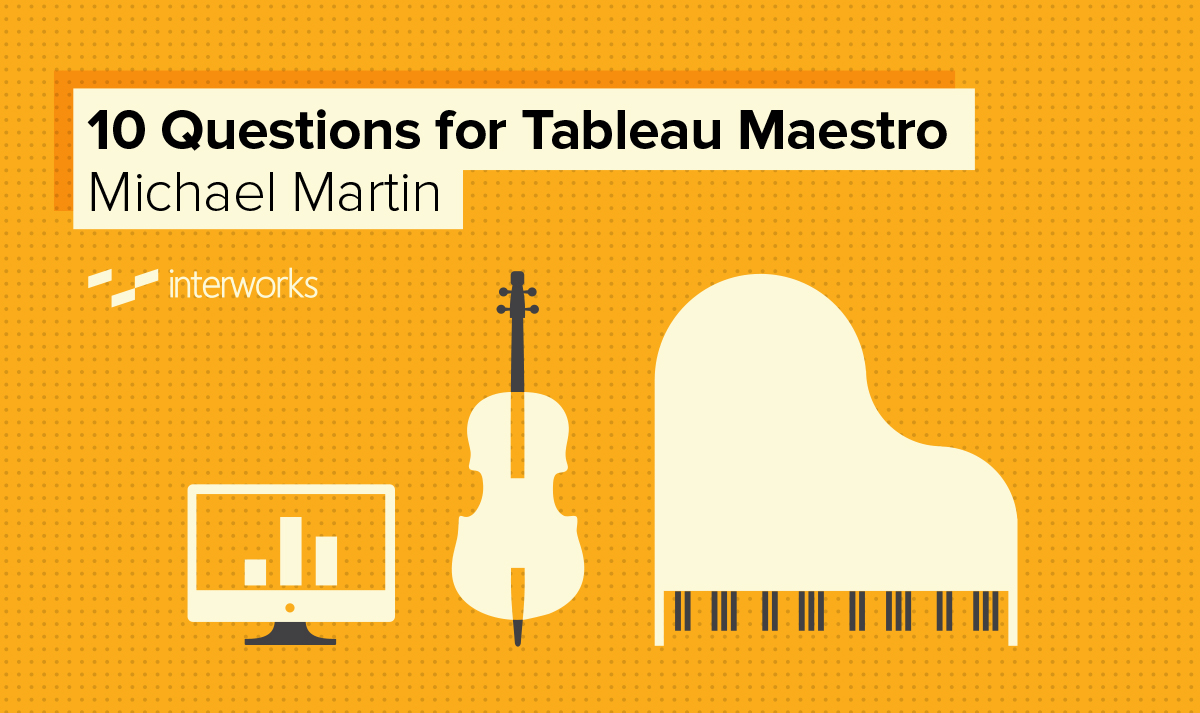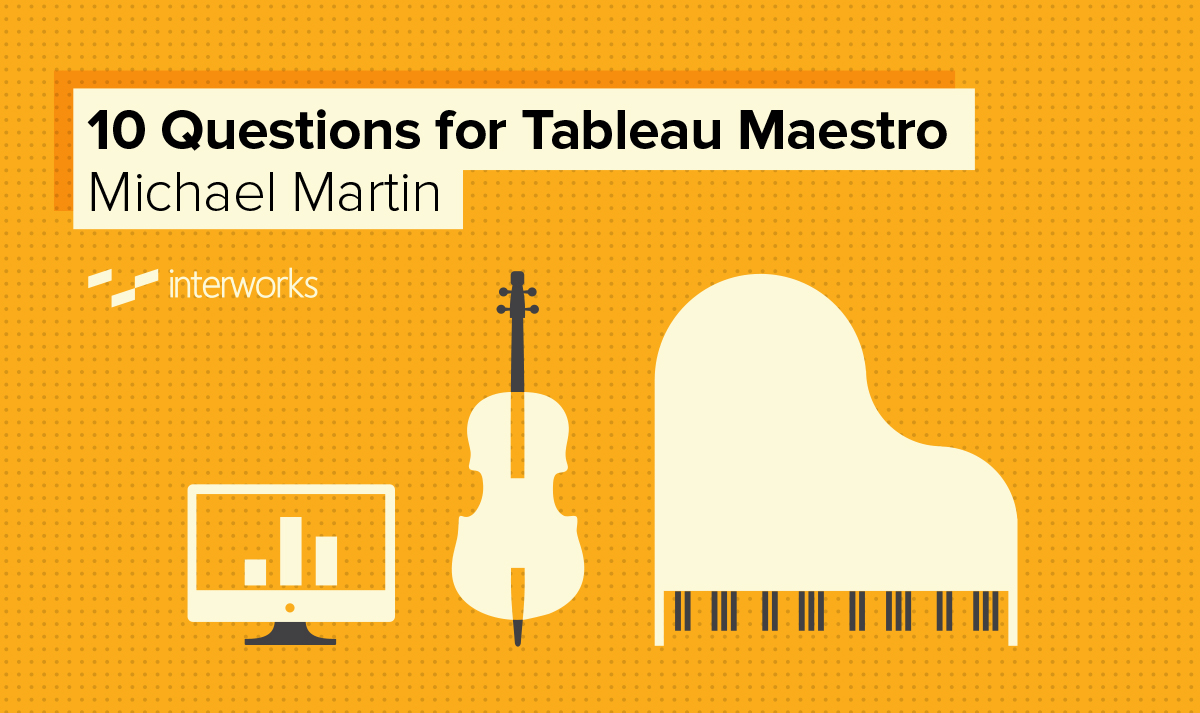10 Questions is an ongoing blog series in which Tableau Zen Master Dan Murray interviews some of the brightest folks in the world of data.

I met Michael at the first or second Tableau Conference. It was particularly memorable meeting him because he is scary smart and his appearance is remarkably similar to Art Garfunkle. Michael specializes in creating impressive social network graphs, performing target customer analysis and integrating market segmentation with product sales data. I recently reconnected with him while speaking at the National Hockey Hall of Fame in Toronto last month. We ended up geeking out, talking about Tableau and data visualization for several hours at dinner that evening. If you have the good fortune to meet Michael, ask questions and listen. You’ll learn something useful.
The Questions
Q: How did you discover Tableau Software so early? V1.0?
Martin: Back In 2005, most legacy data visualization applications and SDKs weren’t aging so well, and I’ve always been on the lookout for interesting tools and technologies. I typically spend a few hours a month scanning the horizon, reading articles and pondering the possibilities. Tableau was one of those references I came across back then, and I knew within minutes that I had made a new and good friend!
Tableau came along at the right time. Tableau was fresh, easy to learn and, more importantly, easy to use. The documentation was well written and had a direct and friendly voice free of “Enterprise Geek-Speak.” The only other data visualization tool you could compare to Tableau at that time is Visokio Omniscope – another fine data visualization platform out of the UK.
Q: You have an early background in music composition. Tell me more about that and why you decided to leave the music field.
Martin: I played various musical instruments growing up, and studied music theory and composition in school and in college. Your question immediately brings Felix Satzer’s and Harold Schachter’s “background, middle ground, foreground” approach to musical analysis to mind. I often look at datasets the same way, hopefully without over-simplifying. There’s usually an active and sometimes volatile foreground (the melody) that tends to attract the most attention. It represents shorter periods or phrases of time, or the behavior of data associated with certain dimensional attributes. This is supported by a slower moving background – the baseline / bass line, representing the governing harmony and longer term trend(s). Sometimes, the middle voices resonate more with the foreground, sometimes more with the background. Occasionally, they take the lead voice in terms of showing what a given business really looks like and why. Depending on the desired analysis, I may focus more one data choir at the expense of others. In one way or another, a dataset is a kind of music score to me. It has a key signature and a meter, with distinct hierarchies and interplay between these hierarchies over time or within sets of dimensional attributes.
I had opportunities to compose music for films and ballet, with some song-writing and record production thrown in. Eventually, I realized that I was the wrong person for the music business at that time of my life. My grand piano and cello are steps away from my desk, both of which I play most every day.
Q: How did you get into technology? What was your first job in tech like?
Martin: My first tech job was working for Scientific Data Systems, Max Palevsky’s old company, writing user and technical documentation in order to earn money for college. I was 17 when I started. I worked summers and over the longer school holiday breaks. I had one blue suit, one pair of good shoes, a couple of white shirts and hair that was too long for some. But, once I got to know the people, we got along fine. Al Winnikoff, who ran the Publications division, was a wonderful and patient boss. I would meet with the engineers and then render their guidance into prose.
Looking back, I am grateful for this window into, what was for me at the time, another world. After college, I moved to Europe to work in the music business. I came back to technology almost a decade later.
Q: You’ve spent some time working in Europe. Tell me about that and your time in Germany.
Martin: I always wanted to live in Europe and have done so for extended periods of time. I lived for several years in London, working as a musician. But the full spectrum of cultural life mesmerized me – especially the Wigmore Hall, which some consider to be the finest hall for chamber music in the world. As I had many periods of under-employment, I could “afford” to spend many hours in the libraries and museums or painting watercolors in St. James’s Park. I discovered literature, met interesting people from many walks of life and visited continental Europe as often as possible.
By the time I was invited by the Brahms Society in Baden-Baden, Germany to live in the house where the composer Johannes Brahms spent nine summers as a “Guest in Residence” for three weeks, I had a data analysis and software company in Los Angeles. I had known about Baden-Baden for years from reading biographies of Brahms. So, when the chance to visit arose, I jumped at it. Brahms came to Baden-Baden to be near his great friend Clara Schumann, who had a summer house nearby. It was love at first sight between me and Baden-Baden. One week later, I met my wife, Barbara, who lived in Clara Schumann’s old house. I moved to Baden-Baden a year-and-a-half later and spent seven wonderful years in Clara Schumann’s house as husband, father of two children and business person.
As a somewhat symbiotic person, I immediately sensed the connections between the music and the landscape – the melodies were in the air, the rich harmonies in the changing weather. I learned the language, made new friends and was very lucky to get permission to form my own company relatively quickly. My clients were always prepared, asked insightful questions, appreciated my efforts to better understand their businesses and encouraged me to experiment in my work. I couldn’t have asked for more. My first so called “Big Data” projects in retail and consumer packaged goods date from this time.
Germany is simply spectacular in so many ways, and I will be forever grateful for the opportunity to live there. My family lives in Toronto now, but I still visit Germany often for personal and professional reasons.
Q: You do some great point of sale analyses for retail businesses. How does Tableau help you do that?
Martin: Tableau’s feature set and palette of mark types makes it possible to develop content for virtually any user. There are people who tend to look at their business more tactically, some more strategically. Some users want “just the numbers” without pictures. That’s no problem for Tableau. If you’re targeting a more right-brained-oriented user community, that’s also no problem for Tableau. The toolbox is rich; you have a solid library of calculations, including the built-in table calculations. Throw in filtering, dashboards, actions, geographic awareness, parameters, R integration, forecasting, text and visual formatting options, web/mobile/cloud platforms, a data server and lots more, and you’ve got a lot of ways to constructively communicate with users and help those users communicate with their peers.
The retail and CPG business sectors have a lot of dimensionality, and Tableau represents dimensionality and key metrics really well. Thanks to Moore’s Law, large volumes of transactional data can be managed within Tableau.
I remember many a pre-Tableau data visualization project where it took me far more time to create user interfaces in code than to organize the data, depending in the viz types required. Tableau was a game changer for me by virtue of providing a great toolbox and UI, with plenty of formatting options for fine tuning. With Tableau, I can focus on modeling the data and the metrics without undue worry about the UI and how it will render on various monitors, browsers or mobile devices.
Q:You listen to a lot of German-language radio. Had that helped with your tech knowledge? If so, how?
Martin: I listen to and watch lots of German language content – a couple of hours a day on average – simply because I am so interested in that part of the world as well as the high quality of the programming, be it news, cultural, or a talk show.
Q: Who inspires you in the Tableau community and why?
Martin: I’m continually impressed by how Tableau Corporate balances the expectations of an ever broadening user base, and how version updates are managed. Tableau upgrades have typically included enhancements for a variety of user types in a very balanced way. Not only has the functionality that made me a 1.0 customer been greatly expanded upon, countless newer enhancements have extended my realm of the possible.
I greatly admire Robert Mundigl’s “Clearly and Simply” blog, which covers a full gamut of BI related content. Robert is one of the most talented developers I have ever met, and a very generous person.
Truly impressive is the work of Tableau’s “Zen Masters,” each of whom have a very distinct identity and share their knowledge so generously. Then there are the many user forum participants who also do so much to help others day in and day out. They also embody a spirit of curiosity and generosity. I like a culture of generosity the best. Tableau Technical Support gets high marks from me as well.
Q: Are there people at Tableau Software whom you have learned from? If so who are they/how?
Martin: I was, and remain, very impressed with and influenced by Christian Chabot’s Tableau Customer Conference keynote in which he passionately advocated the point of view of “the artist” when creating content in Tableau. If I had a video of that keynote, I’d watch it often!
Ty Alevizos and the Alan Smithee.org blog are fabulous and have opened my eyes, as have Marc Reuter’s training videos and presentations. There’s a real astuteness in each of the many Tableau executives I’ve met – people such as Chris Stolte, Francois Ajenstat, Elissa Fink, Pat Hanrahan and Christian Chabot to mention a few. These people not only have something to say, they also listen to and synthesize information very deeply.
Q: Why did you get involved with the Toronto Tableau User Group?
Martin: I wanted Tableau to get a fair hearing in Toronto. Toronto is the fourth largest metropolitan area in North America, and back in 2010, Tableau was practically unknown in Toronto and barely on the map in Canada. I decided to try and do something about that.
A user group seemed to be a good way to demonstrate what a great “Swiss Army Knife” for data Tableau is by discussing a wide variety of use cases with step-by-step instructions that show how a “Tableau Solution” could be built to help people see and understand their data – no bling or hyperbole, “just the facts.” The user group has grown over the years; Tableau has increased its focus on the Canadian market and has fine people with boots on the ground in Canada, resulting in increased interest in Tableau. It’s encouraging to see many new faces at each user group meeting.
Q: How has Tableau changed and improved from V1.0 to V9.0?
Martin: As I mentioned previously, I think Tableau has made a lot of good calls as to what functionality to add over the years. What to add and when is a really big challenge for a software company. You have to consider what customers say, and you have to consider the technical feasibilities. You have to stay true to a vision and stay away from distractions and flavors of the week. There may be disagreements amongst users and pundits as to whether or not pie charts have a place in the 21st-century BI, but looking at the big picture, without taking anything away from (but actually significantly enhancing) the data analyst/consultant user feature set that created the initial “Tableau buzz,” Tableau has responded to the demand for an enterprise-scale reporting platform that extends from the desktop to the web, mobile devices and the cloud. But they have done so in such a way as to not repeat the serious past mistakes legacy “Battleship BI” vendors have made. Tableau has retained its trademark ease of use, remains well documented and looks better than ever.
So what has changed and what has stayed the same? The feature set has certainly expanded drastically; but to me, the “Tableau Development Aesthetic” has stayed pretty much the same. I can still sense the spirit of Tableau 1 in Tableau 9.
Now as then, the more curious and willing to experiment you are, the more Tableau can do for you. Tableau rewards curiosity and experimentation but not always as you might expect.
Last but not least, my kudos to the Tableau web site. Any company who considers themselves a digital business need only closely study tableau.com to see how it’s done. Tableau has never sold one product unit in a box with a printed user manual. I find the development of the website very, very impressive.
To sum it up, Tableau is one of the very few tech sector vendors that has successfully managed the transition (in true “Crossing the Chasm” style) from “upstart” to “major player/market leader” in just a few years, and they show no sign of slowing down yet.
Discover More Interviews
Want to read more insightful interviews like this one? Then you’ll love our 10 Questions blog series. Check out the full list of interviews here, and stay tuned for new additions.
Need Help? Let Us Know!
There you have it. If you need help with your data infrastructure or Tableau, we have the experience, skill, and knowledge to insure your success. Contact us today to learn more.
If you’re in college and think you might want to get into this game, head to our Careers page and apply for one of our open jobs. We’d love to hear from you.







